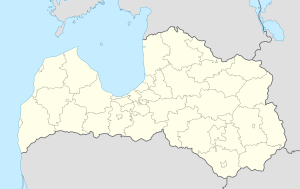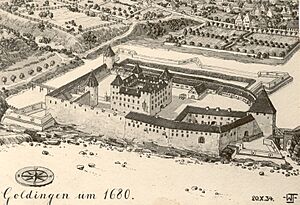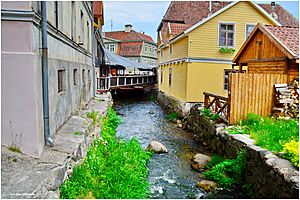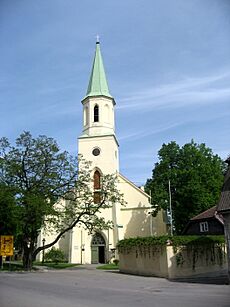Kuldīga facts for kids
Quick facts for kids
Kuldīga
|
|||
|---|---|---|---|
|
Town
|
|||

Kuldīga Old Town
|
|||
|
|||
| Country | |||
| District | Kuldīga Municipality | ||
| Town rights | 1378 | ||
| Area | |||
| • Total | Lua error in Module:Wd at line 1,575: attempt to index field 'wikibase' (a nil value). km2 (Formatting error: invalid input when rounding sq mi) | ||
| • Land | Lua error in Module:Wd at line 1,575: attempt to index field 'wikibase' (a nil value). km2 (Formatting error: invalid input when rounding sq mi) | ||
| • Water | Expression error: Unexpected < operator. km2 (Formatting error: invalid input when rounding sq mi) | ||
| Population
(2024)
|
|||
| • Total | 9,940 | ||
| Time zone | UTC+2 (EET) | ||
| • Summer (DST) | UTC+3 (EEST) | ||
| Postal code |
LV-330(1–3)
|
||
| Calling code | +371 633 | ||
| Number of city council members | 11 | ||
| Website | http://www.kuldiga.lv/ | ||
| Official name: Old town of Kuldīga | |||
| Type: | Cultural | ||
| Criteria: | v | ||
| Designated: | 2023 | ||
| UNESCO region: | Europe | ||
Kuldīga (also known as Goldingen in German) is a charming town in the Courland region of Latvia. It is located in the western part of the country. Kuldīga is the main town of Kuldīga Municipality and has about 13,500 people living there.
Kuldīga was first written about in 1242. It joined the Hanseatic League in 1368. This was a powerful group of trading cities. In the 17th century, Kuldīga was one of the capitals of the Duchy of Courland. It served as a capital from 1596 to 1616, along with Jelgava.
Kuldīga is an old town in Latvia's western region of Kurzeme. It has special buildings that are now part of UNESCO's World Heritage Sites. Many people believe Saint Catherine is the town's patron saint. The oldest church in Kuldīga is named after her. Its foundation was laid in 1252. The church has been changed and updated many times since then.
The small River Alekšupīte flows right through the middle of Kuldīga's old town. It runs along the walls of the houses. The Old Town, with its buildings around this small river, is a unique collection from the 17th and 18th centuries in the Baltic states. A waterfall on the Alekšupīte is 4.2 meters high, making it the tallest in Latvia. The Venta Rapid is a natural waterfall on the Venta River. It is 240 meters wide, making it the widest in Europe. Near this rapid is the Kuldīga brick bridge. It was built in 1874 and is the longest bridge of its kind in Europe. Kuldīga was also chosen as an EDEN destination in 2007.
Contents
History of Kuldīga
The ancient town of Kuldīga grew because of its great location. It was at a crossroads where the River Venta met land routes. These routes connected the Prussian lands with the lower parts of the River Daugava. The old Kuldīga town of the Couronians had a strong castle mound and a settlement. It was located about 3.5 km north of the River Venta. You can still see the castle mound today. It sits on a bank of the River Venta, between the deep gully of the River Veckuldīga and the old Venta valley.
On April 19, 1242, the Livonian Order of Knights got permission to build a castle on the banks of the River Venta. This is the oldest document mentioning Kuldīga. So, 1242 is seen as the year Kuldīga was founded. The Livonian Order built their castle on the left bank of the River Venta, near a place where people could cross the river. They used dolomite stone from the riverbed to build it. By 1263, the castle and the settlements around it were called Goldingen. It was given town rights, based on the rights of Riga.
On April 28, 1355, the Order's master, Goswin von Herike, gave the town new land. He also gave Kuldīga a new special privilege and a coat of arms. This coat of arms showed an image of St. Catherine. From 1439, Kuldīga was allowed to hold a market every week. The town grew by joining three main areas: the town itself, a small village near the castle, and a village on a hill. The Komtur, a leader of the Livonian Order, lived in the castle. He lived there with twelve knight brothers and other helpers who managed the town's economy. The Komtur also led the Kuldīga Komturei, which included other towns like Durbe and Sabile.
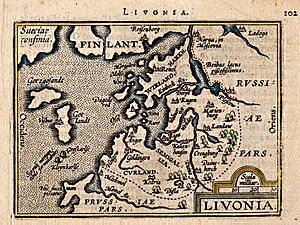
A new time for Kuldīga began in 1561. This was when the Duchy of Courland and Semigallia was created. The first duke, Gotthard Kettler, chose the old castle as one of his homes. He and later dukes supported Kuldīga's town rights. They helped its economy grow. When Duke Gotthard died, the duchy was split into two parts. Until 1618, Kuldīga was the home of his youngest son, Wilhelm, and the capital of Kurzeme. The town earned money from trading with Riga and Jelgava. This was because of taxes on goods that crossed the bridge.
In 1615, a big flood destroyed the bridge. This caused a huge loss for the town. In the same year, a large fire burned down most of the wooden buildings. After the town was rebuilt, a new market place was made. This is the City Council Square today. A new Town Hall was also built. This moved the town's center from near St. Catherine's Church to the new square. The richest citizens and traders built their homes around this new center.
In the late 1800s, small factories started in Kuldīga. Some grew into large factories with over 100 workers. The biggest was "Vulkāns," which made matches from 1878 to 2004. Its matchboxes had a deer on them. Kuldīga also made needles, cigars, soap, vodka, and mineral water. Brewing beer was a long tradition in the town. Many new buildings were built during this time. These included homes, government buildings, and public places. Kuldīga got a new bridge over the River Venta in 1873–74. A new Town Hall was built in 1868. Other new buildings included a church, a prison (now a post office), and a secondary school. The number of people living in Kuldīga doubled. It reached 13,000 just before World War I.
During World War II, the town was under Soviet control from 1940. Then it was under German control from 1941 to 1944.
Sightseeing in Kuldīga
Kuldīga is a small and lovely town in Kurzeme. Poets and painters have always admired it. The historical city center grew in the 17th and 18th centuries. It still has old wooden buildings that form small, narrow streets. The oldest wooden building in Kurzeme, built in 1670, is near the Town Square. The Old Town Hall was built in the 17th century. The town square has always been a place for people to gather. This tradition continues today. The central square is where you can feel the town's energy. It hosts art shows, festivals, and other events.
The Venta waterfall (Ventas rumba) is the widest waterfall in Europe. This natural waterfall is 240 meters wide. It has many old stories and historical events linked to it. In spring, you can see fish jumping up the waterfall. Because of this, Kuldīga was once known as a "place where they catch salmon in the air."
The old brick bridge across the Venta was built in 1874. It is the longest bridge of its kind in Europe, at 164 meters. It was built to 19th-century standards. It was 500 feet long and 26 feet wide, wide enough for two carriages to pass. It has seven brick arches. During World War I, two of the arches were blown up.
The Alekšupīte River flows right along the walls of many buildings. This is why Kuldīga has been called the Venice of Latvia. The buildings in the town center were first built as a part of Kuldīga's outskirts. In 1701, during the Great Northern War, the Swedish army attacked Kuldīga Castle. By 1709, it was too damaged to live in. In the 19th century, the castle ruins were removed.
The Alekšupīte Waterfall was made in the 17th century. Its strong current was used to power the first paper mill in Kurzeme. Every year, a special race is held on the Alekšupīte. Contestants run directly along the river bottom!
St Catherine's Church was first built in 1252. It was later rebuilt with beautiful baroque style wood carvings on the altar. The church is named after St Catherine, the town's patron saint. One of the most successful rulers of the Duchy of Courland, Duke Jacob, was baptized in this church. His wedding to Princess Louise Charlotte of Brandenburg also happened here.
Liepājas street is a street just for walking. It has many buildings from the 17th to 20th centuries. You can see interesting doors and special windows there.
The Sculptress Livija Rezevska's sculpture museum opened in 2003. Visitors can see more than 15 sculptures. They show the Latvian nation, its strength, unity, and love.
The Riežupe Sand Caves are the longest cave system in Latvia. They are about 2 km long in total, and you can explore 460 meters of them. During Duke Jacob's time, sand from these caves was sent by ships to other countries to make glass.
The Synagogue Building
One of the largest buildings in Kuldīga (at 1905 street 6) is the former Jewish synagogue. It was known for its beautiful inside, with marble and gold details. Documents in old Hebrew about its building in 1875 are kept in the Kuldīga District Museum. It was built during the time of Tsar Alexander II. It was a very important place for the Jewish community. The synagogue was part of a larger area. This area included a prayer house, a Jewish cemetery, and a Jewish school. You can still see these today.
The Jewish community had been active in the Duchy of Courland since the 16th century. Many early Jewish people came from Germany. Later, in the mid-17th century, more Jewish people came from Poland. By the 18th century, Jewish people in Kurzeme played an important role in the area's economy.
In 1941, during World War II, the synagogue was used as a holding place for Kuldīga's Jewish residents. After the war, the Germans used the synagogue for food storage. Later, during the early years of the Soviet Union, it became a grain storage building. In 1958, the synagogue was changed into the Kurzeme cinema. It had 450 seats and a reading room. It stayed a cinema until 2003. After Latvia became independent again, it also had a café and a nightclub. As of 2011, the synagogue building was fully changed into the main library of Kuldīga and a place for performances. The building looks grand and new today. However, there are no outside signs of its Jewish past, like Stars of David. The roof decorations seen in old photos are also missing. There is a plaque (as of August 2017) that explains the building's history.
Gallery
Sports in Kuldīga
The Kuldīga Half Marathon is a running race held every year in Kuldīga. It has been taking place since 2006.
Latvia's first indoor arena for athletics opened in Kuldīga in 2008. This means athletes can train and compete indoors.
Famous People from Kuldīga
- Jacob Kettler (1610–1682), a Duke of Courland and Semigallia
- Zelig Kalmanovich (1885–1944), a Jewish expert in languages, translator, and historian
- Ben-Zion Harel (1892–1972), an Israeli doctor and politician
- Max Weinreich (1894–1969), a linguist (someone who studies language)
- James Martin Eder (1838-1921), a pioneer in the sugar industry in Colombia
- Aivis Ronis (born 1968), a politician and diplomat
- Jānis Miņins (born 1980), a bobsledder
- Dana Reizniece-Ozola (born 1981), a politician and chess player
- Jānis Šmēdiņš (born 1987), a beach volleyball player
- Roberts Ozols (born 1995), a footballer
Kuldīga's Sister Cities
Kuldīga has special connections with other towns around the world. These are called twin towns or sister cities:
See also
 In Spanish: Kuldīga para niños
In Spanish: Kuldīga para niños




